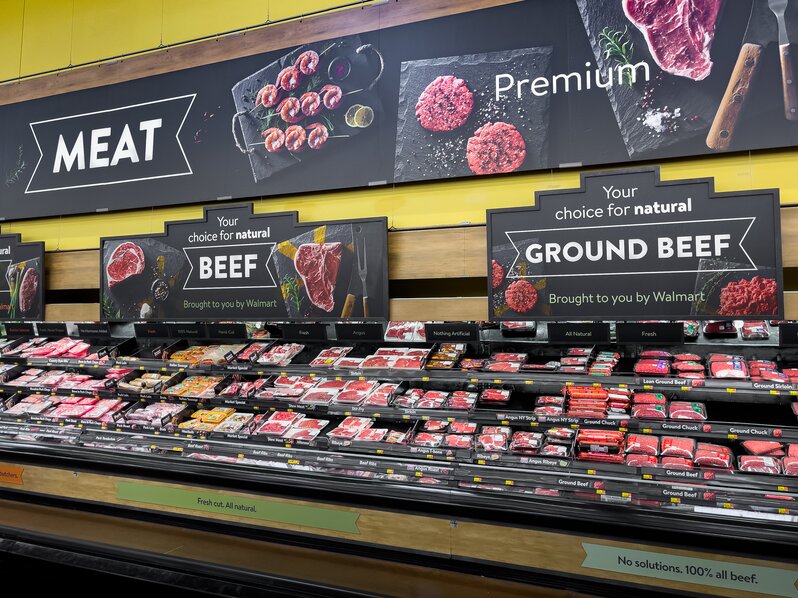America’s Beef Crisis: 75-Year Highs & Rising
Beef Prices Just Hit a 75-Year Threshold — And What It Signals for American Families
America’s beef prices have reached record highs, and the headline numbers only tell half the story. What’s happening inside the U.S. cattle industry right now reveals a much larger shift in the nation’s food security — one that everyday families are already feeling.
Here are the key pressures driving this historic spike, and why experts say the impact is far bigger than a more expensive burger.
1. Prices Aren’t Drifting Up — They’re Breaking Records
Ground beef is up 51% since February 2020, the steepest multi-year climb in modern history. And the average retail price of beef recently surged to $9.69 per pound, the highest ever recorded.
From a market standpoint, increases this large don’t happen from temporary inflation alone. They signal a structural imbalance — meaning something fundamental in the supply chain has changed.
2. America’s Cattle Herd Is Shrinking Faster Than Expected
The U.S. cattle herd has fallen to its smallest size in roughly 75 years.
A decline of this magnitude isn’t the result of a single bad season. It’s the cumulative effect of years of drought, rising feed costs, water shortages, and ranchers exiting the industry because it’s no longer financially sustainable.
This is why USDA analysts expect a 4% drop in beef production this year, followed by another 2% decline next year. That’s not a blip — that’s a trend.
Less cattle → less beef → persistent price increases.
3. Imports Can’t Fill the Gap
In the past, the U.S. has relied on imports to stabilize supply when domestic production dips. But that safety valve isn’t working the way it used to.
- Beef from Brazil is hit with 76% tariffs, slowing imports.
- Health restrictions on Mexican cattle have tightened due to parasite concerns.
- And global supply is tightening too — other nations face similar herd reductions.
When both domestic and international sources tighten at the same time, price relief becomes unlikely.

“We’ve kind of hit this perfect storm … There’s healthy competition for the cattle, and there’s not enough of them to fulfill the demand. And so it has driven prices to historic highs.” — Brady Blackett, third-generation Angus cattle producer.
4. Consumers Are Hitting Their Breaking Point
For the first time in years, the data shows Americans pulling back.
Grocery shoppers increased their ground-beef purchases by about 4% last year, but in a recent July-to-August window, that number flatlined to 0.2% — effectively zero growth.
Restaurants are feeling the strain too, with some regions reporting a 5% decline in foot traffic, especially at places where beef is central to the menu.
Even loyal beef buyers are being priced out.
5. What This Means for Preparedness-Minded Americans
This isn’t just about beef. It’s a case study in how fragile the modern food system can be.
Three deeper trends are at play:
(1) Supply volatility is becoming the norm.
From weather to disease to international policy, the beef supply chain is facing more shocks than it can absorb quickly.
(2) Food inflation doesn’t reverse easily.
When herds shrink this dramatically, it takes years — not months — to rebuild them. Even if prices stabilize, they tend to stabilize at a new normal.
(3) Protein security is becoming a household issue.
Beef is often the bellwether for the broader protein market. When beef climbs, pork, chicken, and shelf-stable alternatives often follow.
For families who value self-reliance and predictable food costs, these trends raise an important question:
If one core part of the food chain can be strained this badly, what else could be next?

6. The Takeaway: Preparedness Isn’t Fear — It’s Strategy
This ongoing beef surge highlights why more Americans are diversifying their food stockpiles and building resilience into their homes.
Not because they expect catastrophe…
But because they expect uncertainty.
The smartest approach isn’t to panic — it’s to plan:
- Mix fresh and long-term food options to protect yourself from short-term price spikes and long-term supply instability.
- Stock protein alternatives so you’re not forced to pay premium prices when the market surges.
- Secure shelf-stable meats now with kits like the 4Patriots Gold Medallion All-Meat Emergency Survival Kit and Ultimate Meat Medley designed to give you real, high-quality protein with a long shelf life, so you’re never dependent on whatever the store is charging that week.
- Build a buffer against market swings so your family meals don’t change every time the supply chain does.
- Reduce reliance on volatile supply chains by keeping dependable basics at home, ready when you need them.
The beef market might eventually cool off. But the factors causing today’s prices — shrinking herds, weather pressure, import limitations, rising production costs — aren’t going away soon.
For anyone committed to preparedness, this moment is less about beef…
and more about the bigger pattern it reveals.
